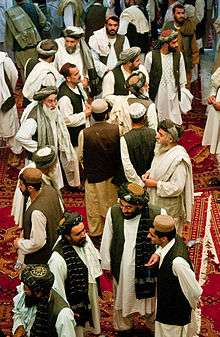Shilmani
 |
| Part of a series on |
| Pashtuns |
|---|
| Kingdoms |
| Religion |
The Shalmani,[1] Shalmani or Sulemani (Pashto: سليمانى,شلمانى) are Pashtun Sub section of Mohmand tribe who are primarily concentrated in the Shalman Valley in Khyber Agency near Peshawar, Khyber Pakhtunkhwa, Pakistan. The tribe is also present in different areas of Pakistan, Afghanistan and Iran. In Pakistan, the tribe lives in Swat, Upper Dir, Lower Dir, Bajour, Buner, Shangla, Abbottabad, Mansehra, Haripur, Malakand District, Dargai, Sakha Koat, Charsadda (Hashtnagar).
Similar to Shalman of Khyber, a city by name Shalman is also present in Gilan Province of Iran and the shalmani associated with Iranian Shalman also speak Pashto and Persian as well.
History
Khan Roshan Khan a Pakhtun historian says that Shalmani were originally brought to Swat District by one of the famous conquerors and kings, Muhammad of Ghor,[2] from Shalman Valley of khyber Agency in present Pakistan and Karman of today's Afghanistan.
M.Saida Khan Shinwari said that Shilmani are Ghoryakhel tribe divided as Shamsher Khel, Halimzai and Kam Shilmanis and considers them to be Mohmand. He states that Shamsher Khels are related to Morcha Khel Mohmands, Halimzai to Halimzai Mohmands and Kam Shilmanis to Tarakzai Mohmands. Officially the Shilmanis are treated as a separate tribe since the Khyber Agreement of 1881. The Shilmanis are closer to Mohmands in characteristics and based on historical evidence they appear to be close kinsmen of the Mohmand.[3]
Hashtnagar
Suleman Shahid suggests In his book, that Shilmani were the strongest tribe among other Pashtun tribes like Dilazak. Primarily they were under Swat District state and Swati King by name Sultan Pakal, but later on Mir Hinda, who was a combatant leader, occupied Hashtnagar and announced it as "Hashtnagar State of Shalmanies".[4]
After centuries when Yusufzai exiled by Mughal Empire from Afghanistan, So Yusufzai tribe attacked on Shilmani tribe and took Charsada Hashtnagar from them with support of Dilazak and other allied tribes of Yusufzai and later gave to Muhammadzai (Charsadda) son of Zamand tribe. Muhammadzai were Yusufzai ally in the battle of bajawar against the Ghoryakhel tribe and Shalmani's are subtribe of Momand Ghoryakhel. Shalmani were very strong and it was unable to defeat them, in the Hashtnagar battle and it was ended after two years.
There are some well known scientists in Iran & Pakistan in different fields like chemistry, biology & nuclear sciences. In Iran's Atomc Energy Commission are known scientists A. M. Shilmani, A Kuchaki Shilmani, & Manzour Shilmani. Similarly, important Shilmani's in Pakistan include former MPA Nek Amal Khan, Jahangir Khan, Rahat Khan and Senator Abdul Malik Shilmani. Many Shilman's serve in the Militia force (FC) and the Pakistan Army.
When Pakistan had not yet come into being, Bacha Khan Shalmani of Sakha Kot Malakand Agency, was the prominent figure of the Shalmani tribe and was a famous politician. Up to this day Shalmani's are going side by side with other Pashtun tribes and are serving the Pakhtoon nation and the humanity in different fields like politics, education, economy, religion, defence and agriculture etc.[4]
References
- ↑ Pete Heiden (2012). Pakistan. ABDO Publishing Company. p. 75.
- ↑ Khan Roshan Khan. Yūsufzaʻī Qaum kī Sarguzasht:K̲h̲ashshī Qabāʻil aur G̲h̲auriyāk̲h̲īl...kī ḥairat angaez, mufassil aur tahqīqī sarguzasht (in Urdu). OCLC 81889189."
- ↑ M. Saida Khan (1926). The Khyber: A Historical Sketch. A.R. Yusuñ. OCLC 5705079.
- 1 2 Sulaimān Shāhid (2005). Gumnām riyāsat : Dīr ke lākhon̲ maz̤lūmon̲ ke nām. Muḥammad Raḥmán Buk Ḍipo. p. 73. OCLC 62110093.
Further reading
- Christian Tripodi (2011). Edge of Empire: The British Political Officer and Tribal Administration on the North-West Frontier 1877-1947. Ashgate Publishing. p. 206. ISBN 9780754694915. OCLC 726826683.
- H.A. Rose (1914). A Glossary of the Tribes & Castes of the Punjab & North-west Frontier Province. Superintendent, Government printing, Punjab. OCLC 635489321.
- H.A. Rose (1997). A Glossary of the Tribes and Castes of the Punjab and North-West Frontier Province. 3. Nirmal Publishers.
- "Tribe, Clan, & Ethnic Genealogies". US Naval Postgraduate School.
- Teepu Mahabat Khan (2005). The land of Khyber. Sang-e-Meel Publications. ISBN 9693517520. OCLC 192109133.
- Shamsur Rahman Shams (1990). The Poets of Malakand. OCLC 24832107.